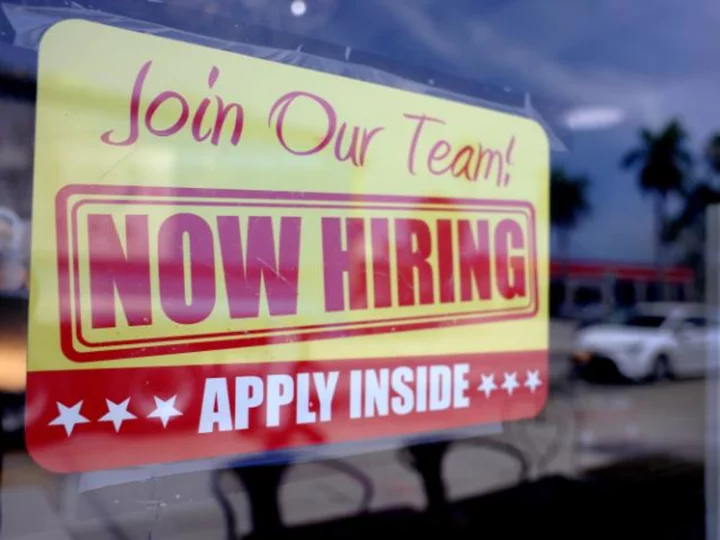Areas of the US economy have started to crack under the weight of persistently high inflation and a string of 10 consecutive rate hikes from the Federal Reserve.
But despite all that, the labor market has kept humming right along. And that's largely expected to be the case, again, in Friday's monthly jobs report from the Bureau of Labor Statistics.
Economists are forecasting a net gain of 190,000 jobs for May, according to Refinitiv. While that would mark a significant retreat from April's surprisingly strong 253,000 jobs added, it would land slightly above the average monthly gains seen during the strong labor market in the years leading up to the pandemic.
Economists are also expecting the unemployment rate to tick back up to 3.5%. The US jobless rate has hovered at decade-lows for more than a year, with the current 3.4% rate matching a 53-year low hit in January.
Private sector employment increased by 278,000 jobs in May, according to ADP's monthly National Employment Report, frequently seen as a proxy for the government's official number.
"In the last few months, the job market has continued to defy gravity, adding a steady clip of jobs and holding unemployment at historically low levels despite a backdrop of rising interest rates, banking turmoil, tech layoffs and debt ceiling negotiations," Daniel Zhao, lead economist at employment review and search site Glassdoor, wrote in a note this week. "After a healthy April jobs report, May is likely to repeat with an equally strong performance."
Consumer spending and the labor market — two ares of strength in the economy — have, in a way, continued to feed on themselves.
Last week, a Commerce Department report showed that not only did the Fed's preferred inflation gauge heat up in April but so did consumer spending. Economists largely attributed consumers' resilience to the healthy labor market as well as ample dry powder stockpiled from home refinances and from the temporary pause in student loan payments.
In turn, that's kept businesses busy.
"With demand for goods and services holding up, employers who have been cautious and have been very nervous about over-hiring are — when push comes to shove — having to keep hiring just to keep pace with business activity," Julia Pollak, chief economist for online employment marketplace ZipRecruiter, told CNN. "They're very worried about a recession later this year, but they need to keep hiring today to provide the pizzas that people are demanding and to prevent flights being canceled."
She added: "Companies have also learned the hard way how costly staffing shortages can be."
But labor shortages are becoming far less acute: This past Memorial Day weekend, 1% of flights were canceled, Pollak said, noting that cancellations were fivefold higher a year before.
"And while that's a good news story — the end of shortages and disruptions during the pandemic is good for most consumers and good for businesses — it does come at some cost, which is a measurable decline in worker and job seeker leverage," she said.
Labor turnover data released Wednesday showed that the US employment market remained tight in April.
Job openings bounced up to 10.1 million positions, bucking economists' predictions for a fourth-consecutive monthly decline, according to the Bureau of Labor Statistics' Job Openings and Labor Turnover Survey report. The jump brought the ratio of vacancies to unemployed to almost 1.8, which is well above a range of 1.0 to 1.2 that is considered consistent with a balanced labor market, according to Michael Feroli, JPMorgan chief US economist.
Although the April JOLTS data showed that fewer people were voluntarily quitting their jobs, the amount of layoffs and discharges dropped during the month, suggesting that employers are continuing to hoard workers, noted economist Matthew Martin of Oxford Economics.
While monthly job gains haven't tailed off as much as anticipated to this point, there is a notable slowdown that's occurred from the blockbuster job gains of the past three years.
But whether the softening is a sign of a return to pre-pandemic form or perhaps of a downswing into a downturn, remains to be seen.
Some of the traditional recession indicators have been flashing red. Layoff announcements have quadrupled so far this year to 417,500, the highest level since 2020, according to a report from Challenger, Gray & Christmas released Thursday. Falling consumer confidence, monthly declines in the Conference Board's Leading Economic Index, and drops in temporary help employment are also signaling that a downturn is just ahead. However, that long-predicted recession isn't here just yet.
"We were in such an unusual place during the pandemic with some of those indicators at completely extraordinary heights that they have experienced extraordinary declines," Pollak said. "But those declines were just a return to normal, not a contraction, and it's not a recession."
New numbers on weekly jobless claims are set to be released Thursday at 8:30 a.m. ET. The government's May jobs report is scheduled for Friday at 8:30 a.m. ET.

